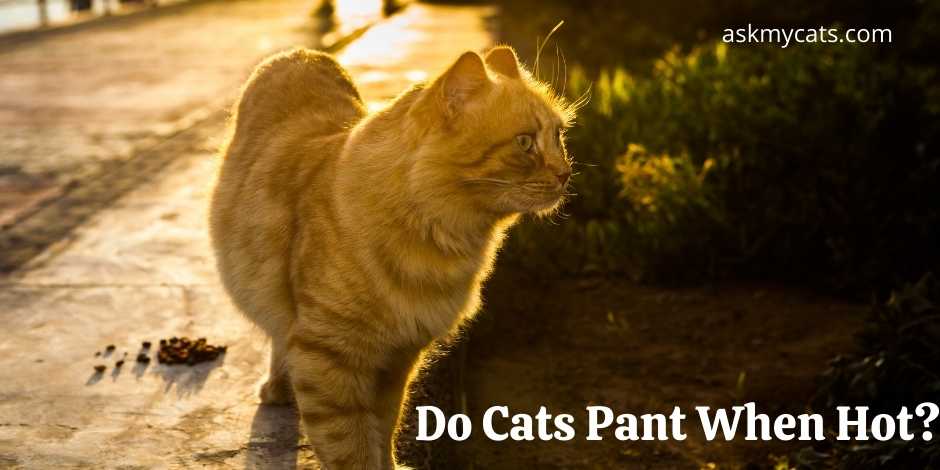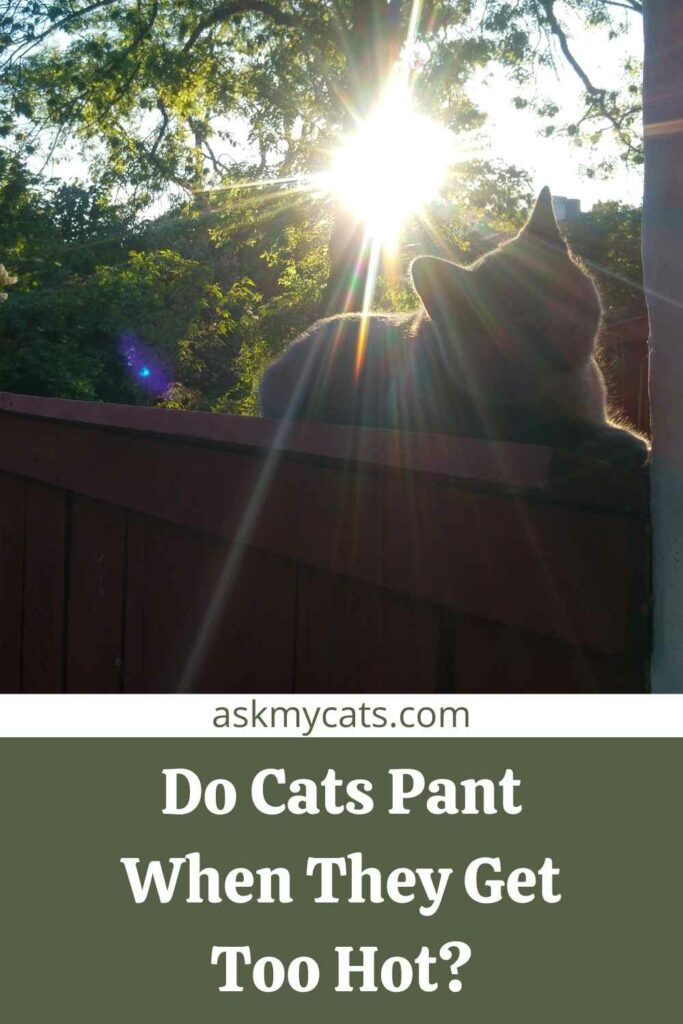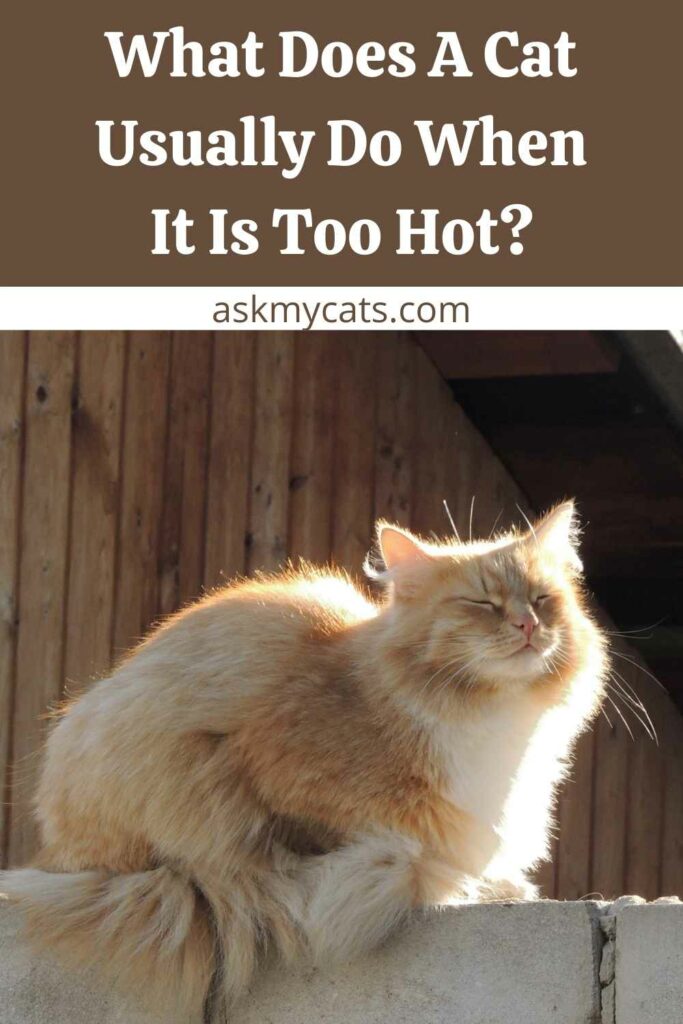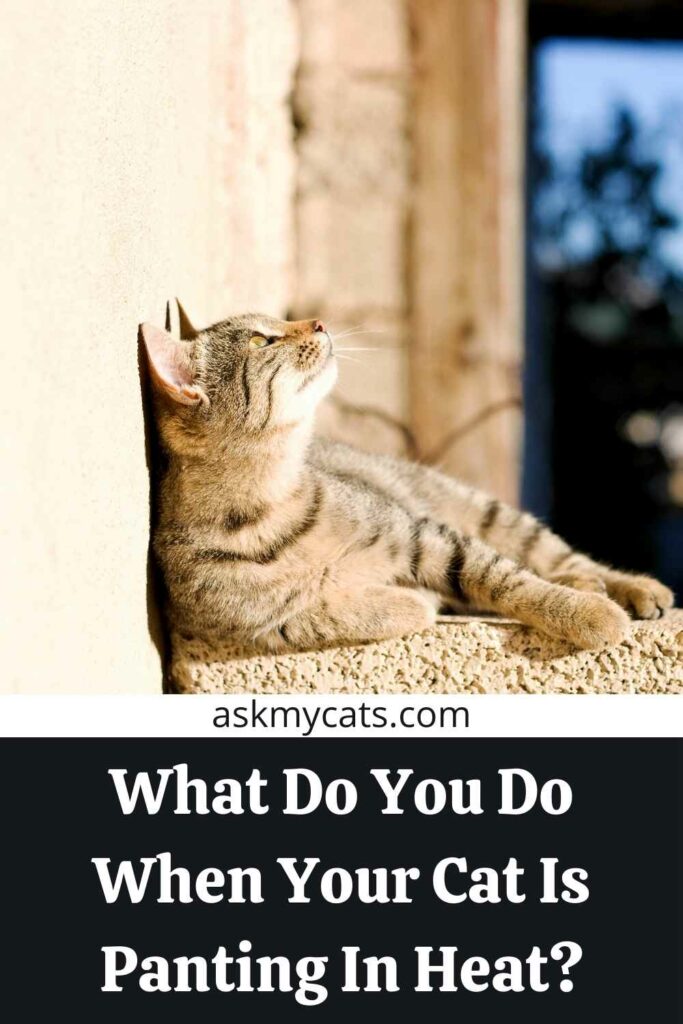Sweating and panting are two ways of controlling body temperature, as you surely already know. Sweat cools the skin as it evaporates while panting releases heat via the mouth.
When it’s really hot, around 90 degrees and all other options have failed, cats begin to pant. That means it’s time to go inside, have a glass of water, and put on the air conditioner. Remember to give your cat some water as well.
Baths that your cat takes regularly operate similarly to sweating does. The body temperature is lowered as saliva evaporates from the hair.


Give Your Cat the Perfect Day
Get the Free Ebook!
Do Cats Pant When They Get Too Hot?
Yes, cats pant when they get too hot to get relief.

Cats, like dogs, have thick coats that keep them insulated. This helps them retain heat in cold weather and repel external heat in warm weather, but this has limitations. High summer temperatures can cause a variety of physiological and behavioral changes.
While high-moisture food can help keep your cat hydrated, the heat might sometimes be too much for them to regulate their body temperature appropriately.
Of course, we’ll be talking mostly about ways to cool down a hot cat, but most cats prefer hotter conditions. This is because they are homeotherms. This implies they can adjust their body temperature as needed and, on average, run a bit hotter than humans.
This isn’t to say that cats can’t overheat, but it does imply that if they do, you will undoubtedly feel the heat as well. It should be simple to figure out if your cat’s strange behavior is related to the temperature.
Cats are born to regulate their body temperature since they are homeotherms. Of course, they can only accomplish so much, but their natural capacity equips them to deal with most regular warm weather situations.
Cats, like dogs, pant to stay cool. Panting permits cold air to move through their bodies, lowering body temperature. You might not notice your cat panting since it is not as frequent in cats as in dogs. Excessive panting indicates that they have difficulty controlling their temperature, and you should act.
Cats, like dogs, sweat through their paws. Sweat aids in eliminating heat from the body by allowing moisture to escape. It’s uncommon that you’ll notice your cat’s feet are sweaty, but this, along with panting, is your cat’s reflexive way of cooling off.
Grooming is another way of cooling off that is specific to cats. When cats groom themselves, they leave a little amount of moisture behind, which, like sweat, aids in the removal of heat from their bodies.
Because cats may be aloof, it’s not always obvious when they’re suffering from the heat. You can do many things to keep your cat cool and comfortable, but knowing how to spot indications that your cat is overheating is crucial.
As the season change, little variations in demeanor are to be expected, but you should be on the watch for harmful, destructive, or unusual behaviors. If your cat is overheated, you may observe the following signs:
If it’s too hot outside, cats may act drowsy. This does not necessarily indicate that they are dangerously hot or unduly uncomfortable; rather, it is their natural mechanism of restricting energy output to maintain a low body temperature.
An overheated cat will also be sluggish. You may be experiencing the early stages of heatstroke or dehydration. As a result, lethargy should always be considered seriously, prompting you to hunt for other symptoms that may suggest that you need to intervene.
What Does A Cat Usually Do When It Is Too Hot?
Cats are seen to be panting, drooling, and agitated when it is too hot.

Cats pant for the same reasons as dogs, but not as frequently or forcefully. Panting after a high-energy round with a cat wand or retrieve, or after a case of the zoomies, is normal, but panting during low-energy activities might indicate that your cat is cooking. Later in this post, we’ll go into cat panting in further detail.
You might not think it’s weird if your cat drools while it purrs, but excessive drooling or drooling in unexpected conditions might be an indication of something more serious. When it’s paired with panting or other behaviors from this list, it’s very informative.
Throwing up is a regular occurrence in cats. Hairballs are common in cats, and they are also prone to regurgitating food after meals. Vomiting with panting, drooling, or drowsiness is problematic for various causes.
Cats are not naturally drawn to water; therefore, most normal home cats are already dehydrated to some degree unless they consume moisture-rich food. Dehydration may lead to various issues, and overheating will dehydrate your cat even more.
Dehydration in cats due to overheating is made more difficult because you may guide a cat to water but not make them drink. Food or tasty water additions may be required to stimulate moisture consumption.
In severe cases of dehydration, your cat will require an intravenous (IV) to refill fluids, so don’t hesitate to contact your veterinarian if you observe indications of dehydration in your cat.
Cat’s body temperatures are usually between 100 and 102 degrees Fahrenheit. If your cat’s body temperature rises beyond 103 degrees Fahrenheit, they are overheating; however, temperatures exceeding 106 degrees Fahrenheit might be dangerous. This indicates that your cat is suffering from heatstroke.
Because heatstroke causes your cat’s organs to shut down, you must act promptly and seek medical help to reduce your pet’s body temperature safely. You may see either vividly colored or very pale gums in addition to the previous indicators of warming.
If you suspect heatstroke, contact your veterinarian right once. Heatstroke can quickly become life-threatening if not treated promptly. Contact your veterinarian for information on how to reduce their body temperature and safely transfer them to the veterinarian.
You might also like to read about do cats like fans
How To Tell If A Cat Is Hot?
If you’re dealing with a continuous heatwave, your cat will most likely exhibit moderate overheating signs; but, if the symptoms don’t go away or begin to increase, your cat may be in danger. Several problems can happen as a result of prolonged overheating:
- Excessive Panting
- Sweaty Feet
- Lethargy
- Vomiting & Diarrhea
- High Body Temperature
- Trembling & Unsteadiness
- Drooling or Salivating
- Red or Pale Gums
You might like to check out how to keep cats cool in summer without ac
What Do You Do When Your Cat Is Panting In Heat?
When the weather is hot, keep your cat cool and comfortable to keep them safe.

It’s simpler to prevent overheating than it is to treat it, so anytime the temperature seems a bit too warm for you, behave as though it’s too warm for your cat as well.
The first item to consider while keeping your cat cool is the surrounding environment. There’s a distinction to be made between indoor and outdoor cats. Because of their surroundings, their behaviors and abilities to regulate their body temperature will change.
Please increase the number of fluids in their routine. A variety of water sources, such as cat water fountains, will encourage your cat to drink more. A higher moisture diet, such as raw cat food or canned meals, will also replace moisture regularly.
Other alternatives for increasing your cat’s daily moisture intake include adding bone broth or goat’s milk to dry diets or feeding as treats.
As previously said, your cat may seek out cool surfaces such as tile or concrete to keep cool. Even if you are not at home, try to leave your cat with safe access to these cooling ways. This might entail leaving bathroom doors ajar or allowing your cat access to the basement.
Place cat trees or chairs in front of fans or air conditioners to keep them out of the way. This will provide a secure haven for your cat to relax. If you don’t offer them easy access to the cooler wind, they can risk climbing furniture or exploring difficult platforms to get closer.
Frozen treats are popular with dogs, but cats are more temperature-sensitive. It would be best to give them a soft, wet treat instead. Whole raw sardines or chicken necks from Big Country Raw are two of their favorites.
Although a lot of cooling gear is made for dogs, it doesn’t imply it can’t be used for cats. Cats aren’t fond of wearing garments, but you don’t have to give them a full-fledged cooling vest. Starting with a basic cooling collar or bandana is a good place to start.
Cooling mats are popular among dogs, but they are not generally suggested for cats, who frequently utilize gel beads to stay cool. If consumed, these gel beads are deadly, and because cats prefer to knead their beds, there’s a good chance they’ll tear the material, exposing the hazardous gel.
Close your curtains to keep the sun out of your face. Cats enjoy laying in the sun, but during the warmest days of the year, you may need to limit your kitty’s sunbathing. This applies to both indoor and outdoor cats. Please place them in locations with plenty of shade and protection from the sun.
Even though your cat enjoys spending time outside, it may be safer to keep them inside until the weather improves. They may not like it, but it is necessary to keep them safe.
Must Read: 5 Simple Ways to Keep Your Indoor Cat Cool During Summer
Frequently Asked Questions
Do cats like fans when it’s hot?
Allow your cat to find a cool spot to rest. In the summer, they’ll naturally flock toward a slate floor or a fan, and in the winter, they’ll huddle up in a warm location. This cooling process is comparable to sweating: the cat cools off when the saliva evaporates from its hair.
Do fans cool cats?
The air blowing will cool every item, animal, or human. A fan (and air conditioner) will undoubtedly help if a cat is hot. As the air passes by, it absorbs part of the heat from the item, then transports or whisks the heat away as it continues to pass.
How hot is too hot for cats?
Cats have a temperature range of 99.5 to 102.5 degrees Fahrenheit. Anything higher than that puts your pet at risk of heatstroke. Your cat’s temperature should never exceed 105 degrees Fahrenheit since heatstroke at that level can be deadly.
Final Words
When your cat becomes overheated, he may start to paint. Rapid breathing, comparable to panting in a dog, helps saliva drain from their tongue, allowing them to chill down.
Drop your queries in the comments section below.
